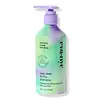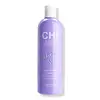What's inside
What's inside
 Key Ingredients
Key Ingredients

No key ingredients
 Benefits
Benefits

 Concerns
Concerns

 Ingredients Side-by-side
Ingredients Side-by-side

Water
Skin ConditioningSodium Cocoyl Isethionate
CleansingCocamidopropyl Betaine
CleansingCocamide Mipa
EmulsifyingDisodium Lauryl Sulfosuccinate
CleansingCannabis Sativa Seed Oil
EmollientLimonium Gerberi Extract
Skin ProtectingZeolite
AbsorbentTapioca Starch
Kaolin
AbrasivePanthenol
Skin ConditioningPolyquaternium-7
Glycol Distearate
EmollientAcrylates Copolymer
Lauramidopropyl Betaine
CleansingSodium C16 Olefin Sulfonate
EmulsifyingSodium Benzoate
MaskingPolyester-37
Skin ConditioningPotassium Sorbate
PreservativeTrisodium Ethylenediamine Disuccinate
Acetic Acid
BufferingCaprylic/Capric Triglyceride
MaskingPhenoxyethanol
PreservativeParfum
MaskingWater, Sodium Cocoyl Isethionate, Cocamidopropyl Betaine, Cocamide Mipa, Disodium Lauryl Sulfosuccinate, Cannabis Sativa Seed Oil, Limonium Gerberi Extract, Zeolite, Tapioca Starch, Kaolin, Panthenol, Polyquaternium-7, Glycol Distearate, Acrylates Copolymer, Lauramidopropyl Betaine, Sodium C16 Olefin Sulfonate, Sodium Benzoate, Polyester-37, Potassium Sorbate, Trisodium Ethylenediamine Disuccinate, Acetic Acid, Caprylic/Capric Triglyceride, Phenoxyethanol, Parfum
Water
Skin ConditioningSodium C14-16 Olefin Sulfonate
CleansingCocamidopropyl Betaine
CleansingGlycol Distearate
EmollientAcrylates Copolymer
Hydrolyzed Ceratonia Siliqua Seed Extract
Skin ConditioningPersea Gratissima Oil
Skin ConditioningSqualane
EmollientLaminaria Digitata Extract
Skin ProtectingPanthenol
Skin ConditioningDisodium Laureth Sulfosuccinate
CleansingPhenoxyethanol
PreservativeCaprylyl Glycol
EmollientPolyquaternium-10
Disodium EDTA
Sorbeth-230 Tetraoleate
EmulsifyingPotassium Sorbate
PreservativeEthylhexyl Stearate
EmollientHexylene Glycol
EmulsifyingDecyl Glucoside
CleansingGlycerin
HumectantSorbitan Laurate
EmulsifyingCitric Acid
BufferingPolyquaternium-7
Zea Mays Starch
AbsorbentGuar Hydroxypropyltrimonium Chloride
Skin ConditioningParfum
MaskingBenzyl Benzoate
AntimicrobialLinalool
PerfumingWater, Sodium C14-16 Olefin Sulfonate, Cocamidopropyl Betaine, Glycol Distearate, Acrylates Copolymer, Hydrolyzed Ceratonia Siliqua Seed Extract, Persea Gratissima Oil, Squalane, Laminaria Digitata Extract, Panthenol, Disodium Laureth Sulfosuccinate, Phenoxyethanol, Caprylyl Glycol, Polyquaternium-10, Disodium EDTA, Sorbeth-230 Tetraoleate, Potassium Sorbate, Ethylhexyl Stearate, Hexylene Glycol, Decyl Glucoside, Glycerin, Sorbitan Laurate, Citric Acid, Polyquaternium-7, Zea Mays Starch, Guar Hydroxypropyltrimonium Chloride, Parfum, Benzyl Benzoate, Linalool
Ingredients Explained
These ingredients are found in both products.
Ingredients higher up in an ingredient list are typically present in a larger amount.
Acrylates Copolymer is used as a film-forming agent and texture enhancer.
After applied, Acrylates Copolymer forms a thin film cover that helps skin feel more soft. It can help sunscreens become more water-resistant.
It is also used to make a product more thick.
Learn more about Acrylates CopolymerCocamidopropyl Betaine is a fatty acid created by mixing similar compounds in coconut oil and dimethylaminopropylamine, a compound with two amino groups.
This ingredient is a surfactant and cleanser. It helps gather the dirt, pollutants, and other impurities in your skin to be washed away. It also helps thicken a product and make the texture more creamy.
Being created from coconut oil means Cocamidopropyl Betaine is hydrating for the skin.
While Cocamidopropyl Betaine was believed to be an allergen, a study from 2012 disproved this. It found two compounds in unpure Cocamidopropyl Betaine to be the irritants: aminoamide and 3-dimethylaminopropylamine. High-grade and pure Cocamidopropyl Betaine did not induce allergic reactions during this study.
Learn more about Cocamidopropyl BetaineGlycol Distearate serves as a pearlizing or opacifying agent in cosmetic products.
It's often included in cleansers and haircare products to give them a lustrous or shimmering appearance.
It is derived from stearic acid, a natural fatty acid commonly found in vegetable oils and animal fats.
Glycol Distearate isn't fungal acne safe.
Learn more about Glycol DistearatePanthenol is a common ingredient that helps hydrate and soothe the skin. It is found naturally in our skin and hair.
There are two forms of panthenol: D and L.
D-panthenol is also known as dexpanthenol. Most cosmetics use dexpanthenol or a mixture of D and L-panthenol.
Panthenol is famous due to its ability to go deeper into the skin's layers. Using this ingredient has numerous pros (and no cons):
Like hyaluronic acid, panthenol is a humectant. Humectants are able to bind and hold large amounts of water to keep skin hydrated.
This ingredient works well for wound healing. It works by increasing tissue in the wound and helps close open wounds.
Once oxidized, panthenol converts to pantothenic acid. Panthothenic acid is found in all living cells.
This ingredient is also referred to as pro-vitamin B5.
Learn more about PanthenolParfum is a catch-all term for an ingredient or more that is used to give a scent to products.
Also called "fragrance", this ingredient can be a blend of hundreds of chemicals or plant oils. This means every product with "fragrance" or "parfum" in the ingredients list is a different mixture.
For instance, Habanolide is a proprietary trade name for a specific aroma chemical. When used as a fragrance ingredient in cosmetics, most aroma chemicals fall under the broad labeling category of “FRAGRANCE” or “PARFUM” according to EU and US regulations.
The term 'parfum' or 'fragrance' is not regulated in many countries. In many cases, it is up to the brand to define this term.
For instance, many brands choose to label themselves as "fragrance-free" because they are not using synthetic fragrances. However, their products may still contain ingredients such as essential oils that are considered a fragrance by INCI standards.
One example is Calendula flower extract. Calendula is an essential oil that still imparts a scent or 'fragrance'.
Depending on the blend, the ingredients in the mixture can cause allergies and sensitivities on the skin. Some ingredients that are known EU allergens include linalool and citronellol.
Parfum can also be used to mask or cover an unpleasant scent.
The bottom line is: not all fragrances/parfum/ingredients are created equally. If you are worried about fragrances, we recommend taking a closer look at an ingredient. And of course, we always recommend speaking with a professional.
Learn more about ParfumPhenoxyethanol is a preservative that has germicide, antimicrobial, and aromatic properties. Studies show that phenoxyethanol can prevent microbial growth. By itself, it has a scent that is similar to that of a rose.
It's often used in formulations along with Caprylyl Glycol to preserve the shelf life of products.
Polyquaternium-7 is a light to clear colored liquid. It is commonly found in haircare products for its film-forming and anti-static properties.
According to a manufacturer, it is a non-paraben and specially developed for negatively charged surfactant systems. This makes it a great hairstyle holder and helps to improve wet hair detangling without adding buildup.
Potassium Sorbate is a preservative used to prevent yeast and mold in products. It is commonly found in both cosmetic and food products.
This ingredient comes from potassium salt derived from sorbic acid. Sorbic acid is a natural antibiotic and effective against fungus.
Both potassium sorbate and sorbic acid can be found in baked goods, cheeses, dried meats, dried fruit, ice cream, pickles, wine, yogurt, and more.
You'll often find this ingredient used with other preservatives.
Learn more about Potassium SorbateWater. It's the most common cosmetic ingredient of all. You'll usually see it at the top of ingredient lists, meaning that it makes up the largest part of the product.
So why is it so popular? Water most often acts as a solvent - this means that it helps dissolve other ingredients into the formulation.
You'll also recognize water as that liquid we all need to stay alive. If you see this, drink a glass of water. Stay hydrated!
Learn more about Water